When I was a young boy my father taught me many things about plants, animals, nature, and how to live in the woods. As a result I became interested in wildlife and camping. I was fascinated by the stories I read about the adventures of the Voyagers – the French Canadian fur trappers who canoed the northern lakes and rivers during the 17th and 18th centuries when beaver furs were in demand. I thought I would like to try living in the wild, canoeing the wilderness, navigating with map and compass the way the Voyagers did.
After living in tents furnished by the U.S. government for a couple of years I somehow lost interest in wilderness camping, but many years later upon hearing about the canoe areas in Northern Minnesota and Ontario, my interest was revived. I thought this may be a nice way to spend a couple of weeks in the summer, get away from the noise, and perhaps gain a new appreciation for the conveniences we have as modern people.
After doing some research and having winter meetings, seven of us decided to give it a try in the summer of 1984 . We picked Sawbill Lake in the Boundary Waters canoe area to have our first wilderness adventure. This lake is just north of Tofte, Minnesota, a town of about 250 people.
The boundary Waters is a wilderness area in the Superior National Forest of Northern Minnesota reserved by the U.S. government for camping and canoeing. It is on the southern edge of the Canadian border just north of Lake Superior, consists of about one million acres of lakes and virgin forest, and is covered with old Indian and Voyager trails. There are over 1100 lakes and hundreds of miles of streams and trails. It is as close to pristine wilderness as can be found in the continental U.S. For the most part no motorized vehicles are allowed in, and planes are forbidden to fly over. An entry permit is needed, and the number of people allowed to enter is limited. There are designated camping areas provided by the U.S. forest service, each with a fire grate and wooden box with an appropriate-sized hole in the top to serve as a latrine. No tin cans or glass bottles are allowed. Anything taken in must be carried back out.
There is also a canoe camping area in Canada just north of the U.S. border, Quetico Provincial Park. It is even larger and more primitive than the Boundary Waters. No designated camping areas or latrines are provided.
Armed with provisions, maps, compasses, entry permits, and after finding an outfitter who provided canoes, seven determined campers headed for Tofte, a 22 hour drive from our homes in Ohio. Besides me, there was my brother Mark and my son Chris, Dave Chlysta and his nephew Donnie, Eileen Kutinsky and her sister Vivian.
We arrived at a public campground at the south end of Sawbill Lake where we left our cars, slept overnight, and took a final shower before embarking on our big adventure.
While showering I overheard a couple of campers who had just come in from Sawbill talking about having trouble with bears. I didn’t give it much thought at the time. I knew that bears were in there but I had some knowledge about how to protect against them. I knew that we had to hang our food with ropes between two trees, so high that bears didn’t believe they could get to it. If they believed they could get it, they would! I also knew that unlike grizzly bears, black bears generally do not attack humans.
Being inexperienced at canoe camping we went overboard in our choices of things to bring. We worried more about comfort than weight (mistake number one). It should have been the opposite, since everything needs to be carried on a portage-including the canoes. We brought a cooler, camp stove, whole eggs, potatoes, steaks, hot dogs, and other things we thought we might need to live in the wilds for a week. My brother even brought a small wooden keg full of 151 proof Ronrico rum to help keep us warm during those chilly nights, and I brought a practice guitar so I could keep my “pickin’ fingers” limber.
So off we went into the boonies with our stuff loaded into 4 canoes. We must have looked like the Oakies headed for California in “The Grapes of Wrath”. After 5 or so miles of paddling we found an empty campsite. It was the closest one to the public campground and first one we encountered. We set our camp up there (mistake number two). After unloading our stuff and setting up tents, we decided to use this site as a base camp and take day trips for fishing and exploring.
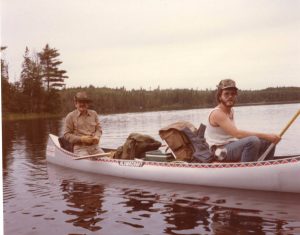
Mark, Chris
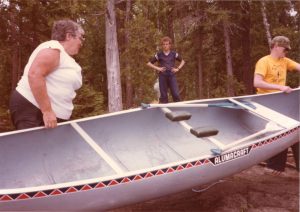
Eileen, Donnie, Dave
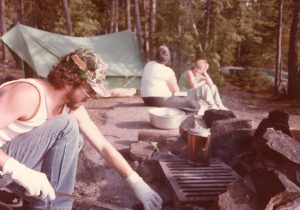
Chris, Eileen, Vivian
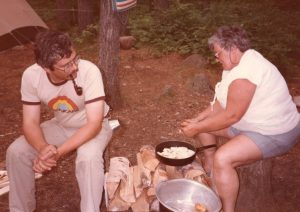
Eileen peeling potatoes and Mark giving advice
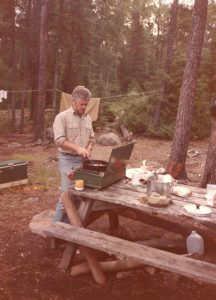
Gene making breakfast
We noticed that there was some amount of paper and trash strewn around, a sure sign that bears had visited the previous occupants. We didn’t let that discourage us (mistake number three). After all, we didn’t see any bears. They were gone.
That night they were back!
Fortunately we had strung our food up and the bears couldn’t get it. They just pussy-footed around the camp for awhile and then left. Black bears are not normally aggressive, but they will trash the place looking for food when the occupants are away or asleep. We always hoisted the food and left the tents open when leaving the camp so the bears wouldn’t tear them open while trying to get in (Bears seem to have trouble with zippers).
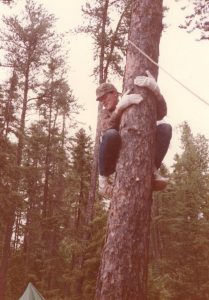
Dave putting up bear ropes

Checking to see if the Duluth pack was high enough to be bear-proof
If the bears do get the food and you are many days from a grocery store and civilization, it will definitely add stress to the trip!
We had to hoist the heavy cooler full of eggs, steaks, and other food into the trees, and the rum had to go up. After all, we didn’t want a bunch of rummed-up bears staggering around the camp making nuisances of themselves !
That was too much for our ropes. One night a rope broke and the cooler came swinging down, banging against a tree with a loud thud. I heard Eileen exclaim as she poked her head out of her tent, “Well, that’s probably it for the eggs”.
It was.
We limited our activities to Sawbill Lake except for a couple of instances when we portaged into nearby lakes and rivers, always returning to our original camp at night.

Portaging to Ada Lake
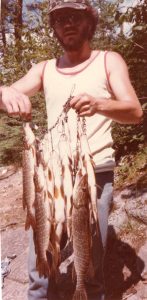
Ada Lake was crawling with Northern Pike
About 50 yards across the lake was a large island with a campsite in view of ours. I noticed that a couple had set up camp there. One afternoon we heard a blood-curdling scream coming from their camp. Dave and I ran over to the water’s edge and saw a girl running back and forth waving her arms and screaming. We jumped into a canoe and headed over, having no idea what we would find. The hysterical girl told us that a big black bear had run away with the couple’s Duluth pack-in it was their food, passports, and other supplies.
“Eet vas beeg and black and vent dat vay”, she said with a European accent, and pointed to a path in the woods.
I immediately ran in the direction she was pointing. I wanted to recover the pack before too much damage was done, but was not thinking of what I would do if I encountered the bear. After about 200 feet of running I spotted a very large black bear, perhaps 400 pounds, ripping up a Duluth pack on the ground. He looked up from the pack and turned his gaze menacingly toward me.
I wasn’t sure whether to run, wait for Dave, or say my prayers. I bravely (stupidly?) took a step toward the bear and he took a step backward, so I knew I had him. I ran after the bear, he abandoned the pack and I chased him into the woods. He obviously didn’t know how scared I was.
Upon surveying the damage to the pack, we found some well-mauled food wrappers, a toothpaste tube-the only thing left was the lid part, a squeeze Parkay bottle that was licked clean, but looking as if it had been run through a shredder, and various other torn-up articles. The bear must have had no intention of doing any foreign travel since the 2 passports were there, undamaged and intact.
The girl, Marja, was a stewardess for KLM Royal Dutch Airlines. She had a lay-over at Duluth Airport, so she decided to take advantage of this time to do some wilderness camping with her boyfriend, Roger, who was definitely not a camper. They had hoisted their pack up into a tree and decided to take a nap. They didn’t get the pack far enough away from the trunk, so the bear just shinnied up the trunk and grabbed it.
They were so un-nerved by the bear incident that they asked to stay with us (also the bear had eaten their food). We agreed and they turned out to be delightful company.
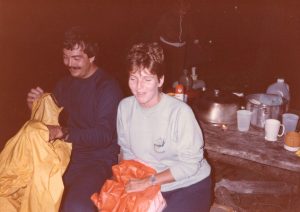
Roger and Marja
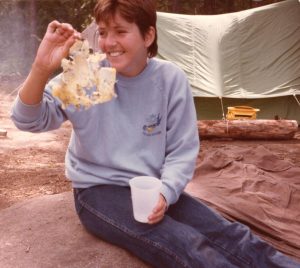
Not much left of the Squeeze Parkay
Every night we were visited by bears looking for food, but we somehow managed to keep it away from them.
After a week or so of camping we came back to the public campground to shower and return the canoes.We then headed for the closest restaurant for some real food and a beer. Then came the long ride back to Ohio in our cars with their comfortable soft seats and means of locomotion that required no paddling.
While at the public campground we found the cause of our bear problem. This place was crawling with bears at night, raiding dumpsters, banging the lids, jumping on car hoods, and generally making nuisances of themselves. They were no longer afraid of humans and looked to them for easy food. Our camp had been too close to this “bear factory”. On subsequent trips we made sure that we camped several miles from public camp grounds and other forms of civilization.
On arriving home I enjoyed not having to hoist the food I bought from Kroger’s up into a tree, but merely placing it in the fridge. I didn’t have to set up my tent every night in the rain, spend hours gathering and cutting firewood, or fighting with hoards of mosquitoes. I had a nice soft sofa and didn’t get “boundary buns” from sitting on a rock. I could turn on the shower and hot water would come out. I was living large!
I once again appreciated civilization and the conveniences it offered, but after several months of “living large” I missed the Boundary Waters and knew that I would someday return.
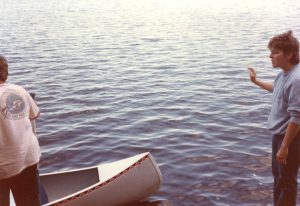
More pictures HERE
From Margaret:
I think you mislabeled the photo with the loons. Hope you had a good birthday!
Gene replied:
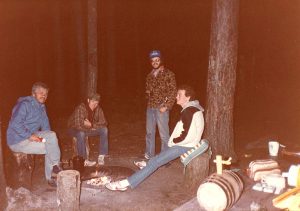
Thanks, Margaret.
Is this better?
_________LOONS_______